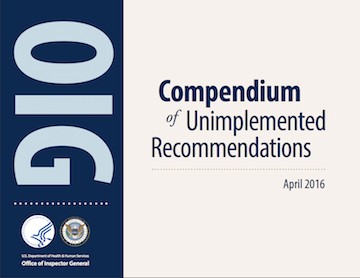
The Centers for Medicare & Medicaid Services could be wasting taxpayer dollars by not reducing financial incentives for hospices to target certain Medicare beneficiaries living in assisted living communities, according to a new report by the U.S. Department of Health and Human Services Office of Inspector General.
In January 2015, the OIG recommended that CMS find a way to decrease incentives that make it attractive for hospices to seek assisted living residents who have certain diagnoses or are likely to have long stays. The office’s 2016 “Compendium of Unimplemented Recommendations,” however, notes that CMS has not implemented the recommendation.
The compendium lists the top 25 unimplemented recommendations that the OIG believes “would most positively impact HHS programs in terms of cost savings and/or quality improvements and should, therefore, be prioritized for implementation.” Items on the list are not ranked.
“We found that Medicare payments for hospice care in ALFs [assisted living facilities] more than doubled in 5 years, totaling $2.1 billion in 2012,” according to the OIG. “Hospices provided care much longer and received much higher Medicare payments for beneficiaries in ALFs than for beneficiaries in other settings.”
Hospices typically provided fewer than five hours of visits and were paid about $1,100 per week for each beneficiary receiving routine home care in assisted living, according to the report, and for-profit hospices received “much higher” Medicare payments per beneficiary than nonprofit hospices.
Under the current payment system, the OIG maintains, hospices may target Medicare beneficiaries who live in assisted living communities “because they may offer hospices the greatest financial gain.” But Medicare beneficiaries receiving hospice care in assisted living communities often have diagnoses that require less complex care, according to the report. “The findings in this and previous OIG reports show that payment reform and more accountability are needed to reduce incentives for hospices to focus solely on certain types of diagnoses or settings,” the OIG says.
The publication notes that CMS agreed with the recommendation and said it is analyzing possible reform options. A previously issued final rule that will differentiate payments for routine home care based on the beneficiary’s length of stay may address the issue, CMS says, but the OIG questions whether changing the payment structure as outlined in that final rule is the best way to meet its recommendation.



